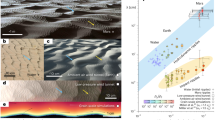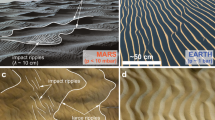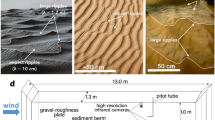Abstract
Periodic sediment patterns have been observed on Earth in riverbeds and sand and snow deserts, but also in other planetary environments. One of the most ubiquitous patterns, familiar wind or ‘impact’ ripples, adorns sand beaches and arid regions on Earth. The observation of aeolian impact ripples on Mars the same size as their terrestrial counterparts despite a thinner atmosphere raises questions about their formation. Here we show in a numerical simulation that the emergent wavelength of impact ripples is controlled by the mechanics of grain–bed impacts and not the characteristic trajectories of grains above the bed. We find that the distribution of grain trajectories in transport is essentially scale-free, invoking the proximity of a critical point and precluding a transport-related length scale that selects ripple wavelengths. By contrast, when a grain strikes the bed, the process leading to grain ejections introduces a collective granular length scale that determines the scale of the ripples. We propose a theoretical model that predicts a relatively constant ripple size for most planetary conditions. In addition, our model predicts that for high-density atmospheres, such as on Venus, or for sufficiently large sand grains on Earth, impact ripples propagate upwind. Although wind-tunnel and field experiments are needed to confirm the existence of such ‘antiripples’, we suggest that our quantitative model of wind-blown sediment transport may be used to deduce geological and environmental conditions on other planets from the sizes and propagation speeds of impact ripples.
This is a preview of subscription content, access via your institution
Access options
Access Nature and 54 other Nature Portfolio journals
Get Nature+, our best-value online-access subscription
$32.99 / 30 days
cancel any time
Subscribe to this journal
Receive 12 print issues and online access
$259.00 per year
only $21.58 per issue
Buy this article
- Purchase on SpringerLink
- Instant access to full article PDF
Prices may be subject to local taxes which are calculated during checkout




Similar content being viewed by others
Data availability
Data from discrete element model (DEM) simulations used in this study are available via Figshare at https://doi.org/10.6084/m9.figshare.28199654 (ref. 38).
Code availability
Code for the discrete element model (DEM) used in this study can be made available on request.
References
Charru, F., Andreotti, B. & Claudin, P. Sand ripples and dunes. Annu. Rev. Fluid Mech. 45, 469–493 (2013).
Duran Vinent, O., Andreotti, B., Claudin, P. & Winter, C. A unified model of ripples and dunes in water and planetary environments. Nat. Geosci. 12, 345–350 (2019).
Bagnold, R. A.The Physics of Blown Sand and Desert Dunes (Courier Corporation, 2012).
Lapotre, M. et al. Large wind ripples on mars: a record of atmospheric evolution. Science 353, 55–58 (2016).
Yizhaq, H. et al. Coevolving aerodynamic and impact ripples on Earth. Nat. Geosci. 17, 66–72 (2024).
Anderson, R. S. A theoretical model for aeolian impact ripples. Sedimentology 34, 943–956 (1987).
Nishimori, H. & Ouchi, N. Formation of ripple patterns and dunes by wind-blown sand. Phys. Rev. Lett. 71, 197 (1993).
Prigozhin, L. Nonlinear dynamics of aeolian sand ripples. Phys. Rev. E 60, 729 (1999).
Csahók, Z., Misbah, C., Rioual, F. & Valance, A. Dynamics of aeolian sand ripples. Eur. Phys. J. E 3, 71–86 (2000).
Durán, O., Claudin, P. & Andreotti, B. Direct numerical simulations of aeolian sand ripples. Proc. Natl Acad. Sci. USA 111, 15665–15668 (2014).
Andreotti, B., Claudin, P., Iversen, J. J., Merrison, J. P. & Rasmussen, K. R. A lower-than-expected saltation threshold at Martian pressure and below. Proc. Natl Acad. Sci. USA 118, e2012386118 (2021).
Miller, J., Marshall, J. & Greeley, R. et al. Wind Ripples in Low Density Atmospheres (NASA, 1987).
Andreotti, B., Claudin, P. & Pouliquen, O. Aeolian sand ripples: experimental study of fully developed states. Phys. Rev. Lett. 96, 028001 (2006).
Greeley, R., Marshall, J. & Leach, R. Microdunes and other aeolian bedforms on venus: wind tunnel simulations. Icarus 60, 152–160 (1984).
Durán, O., Andreotti, B. & Claudin, P. Numerical simulation of turbulent sediment transport, from bed load to saltation. Phys. Fluids 24, 103306 (2012).
Pähtz, T. & Durán, O. Unification of aeolian and fluvial sediment transport rate from granular physics. Phys. Rev. Lett. 124, 168001 (2020).
Pähtz, T. & Durán, O. Scaling laws for planetary sediment transport from dem-rans numerical simulations. J. Fluid Mech. 963, A20 (2023).
Lämmel, M. & Kroy, K. Analytical mesoscale modeling of aeolian sand transport. Phys. Rev. E 96, 052906 (2017).
Ho, T. D., Valance, A., Dupont, P. & El Moctar, A. O. Aeolian sand transport: length and height distributions of saltation trajectories. Aeolian Res. 12, 65–74 (2014).
Rasmussen, K. R., Valance, A. & Merrison, J. Laboratory studies of aeolian sediment transport processes on planetary surfaces. Geomorphology 244, 74–94 (2015).
Ungar, J. E. & Haff, P. Steady state saltation in air. Sedimentology 34, 289–299 (1987).
Olami, Z., Feder, H. J. S. & Christensen, K. Self-organized criticality in a continuous, nonconservative cellular automaton modeling earthquakes. Phys. Rev. Lett. 68, 1244 (1992).
Gabriel, A.-A., Garagash, D. I., Palgunadi, K. H. & Mai, P. M. Fault size–dependent fracture energy explains multiscale seismicity and cascading earthquakes. Science 385, eadj9587 (2024).
Durán, O., Claudin, P. & Andreotti, B. On aeolian transport: grain-scale interactions, dynamical mechanisms and scaling laws. Aeolian Res. 3, 243–270 (2011).
Yan, L., Barizien, A. & Wyart, M. Model for the erosion onset of a granular bed sheared by a viscous fluid. Phys. Rev. E 93, 012903 (2016).
Ammi, M., Oger, L., Beladjine, D. & Valance, A. Three-dimensional analysis of the collision process of a bead on a granular packing. Phys. Rev. E 79, 021305 (2009).
Owens, E. T. & Daniels, K. E. Sound propagation and force chains in granular materials. Europhys. Lett. 94, 54005 (2011).
Furbish, D. J., Haff, P. K., Roseberry, J. C. & Schmeeckle, M. W. A probabilistic description of the bed load sediment flux: 1. theory. J. Geophys. Res. Earth Surf. 117, F03031 (2012).
Makeev, M. A., Cuerno, R. & Barabasi, A.-L. Morphology of ion-sputtered surfaces. Nucl. Instrum. Methods Phys. Res. B 197, 185–227 (2002).
Ziberi, B., Frost, F., Höche, T. & Rauschenbach, B. Ripple pattern formation on silicon surfaces by low-energy ion-beam erosion: experiment and theory. Phys. Rev. B 72, 235310 (2005).
Werner, B. & Gillespie, D. Fundamentally discrete stochastic model for wind ripple dynamics. Phys. Rev. Lett. 71, 3230 (1993).
Landry, W. & Werner, B. Computer simulations of self-organized wind ripple patterns. Physica D 77, 238–260 (1994).
Huntley, D. A., Coco, G., Bryan, K. R. & Murray, A. B. Influence of ‘defects’ on sorted bedform dynamics. Geophys. Res. Lett. 35, L02601 (2008).
Werner, B. & Kocurek, G. Bedform spacing from defect dynamics. Geology 27, 727–730 (1999).
Walker, J. D. An Experimental Study of Wind Ripples. PhD thesis, Massachusetts Institute of Technology (1981).
Schmerler, E., Katra, I., Kok, J. F., Tsoar, H. & Yizhaq, H. Experimental and numerical study of Sharp’s shadow zone hypothesis on sand ripple wavelength. Aeolian Res. 22, 37–46 (2016).
Cheng, H. et al. Experimental study of aeolian sand ripples in a wind tunnel. Earth Surf. Process. Landf. 43, 312–321 (2018).
Lester, C. W., Murray, A. B., Duran, O., Andreotti, B. & Claudin, P. Emergence of wind ripples controlled by mechanics of grain–bed impacts. Figshare https://doi.org/10.6084/m9.figshare.28199654 (2025).
Acknowledgements
This research is dedicated to Peter Haff. We thank P. Haff, B. T. Werner and D. J. Furbish for their valuable insights and helpful thoughts.
Author information
Authors and Affiliations
Contributions
C.W.L. conducted DEM simulations, derived the analytical model, interpreted results and generated plots. A.B.M. contributed to model development and interpretations of results. O.D., B.A. and P.C. developed the DEM and contributed to analytical modelling. All authors contributed to writing.
Corresponding author
Ethics declarations
Competing interests
The authors declare no competing interests.
Peer review
Peer review information
Nature Geoscience thanks Alexandre Valance and Nathalie Vriend for their contribution to the peer review of this work. Primary Handling Editor: Tamara Goldin, in collaboration with the Nature Geoscience team.
Additional information
Publisher’s note Springer Nature remains neutral with regard to jurisdictional claims in published maps and institutional affiliations.
Extended data
Extended Data Fig. 1 Scale-free temporal fluctuations in the number of grains in transport.
(a-d) DEM simulations of transport on Earth showing a time series of the number of grains in transport per unit area n(t) rescaled by the average N ≈ 1/50d2. Panel (b) is the zoomed in box outlined in (a) and (c) is the black box in (b) and similarly (d) is the zoomed box of (c). Panel (e) shows the spectrum of fluctuations in n(t) of a given frequency \(| \hat{n}(f)|\) (that is, the square root of the power spectrum). The spectrum shows a power law decay as 1/f hinting at the critical sensitivity of the granular surface: With the wind shear stress at the bed buffered to the threshold of motion10,24, the bed is sensitive to perturbations. In this condition, when an impact ejects grains that then go on to eject other grains, and so on, this feedback can cascade into large bursts of transport (Supplementary Videos). These cascades cause fluctuations in transport across a range of scales. Highlighted by the solid markers in (e) are the frequency windows used in (a-d). Note that (b-d) fall in the scale-free region. The insets in (e) show the spectrum for Mars (red), Earth (blue), Titan (green) and Venus (gold) all showing similar scale-free \(| \hat{n}| \propto 1/f\) spectra. We note that the subtle peaks in the spectral density around \(f \approx 0.03\sqrt{g/d}\) and \(f \approx 0.4\sqrt{g/d}\) correspond to the characteristic transport time scales. The \(f \approx 0.03\sqrt{g/d}\) peak is set by the average travel time scale related to 〈ℓ〉 (therefore this peak occurs at smaller frequencies on Mars; see inset). And the \(f \approx 0.4\sqrt{g/d}\) peak is set by the average ejection time scale—the time it takes for grains to go from bed-bound to ’counted’ as a part of transport.
Extended Data Fig. 2 Geometric effects on hop length modulations.
(a) Cotangent of impact angles \(\cot \theta (\ell )\) for Mars (red), Earth (blue), Titan (green) and Venus (gold) conditions, measured from DEM simulations. \(\cot \theta (\ell )\) is rescaled by its average for clarity of presentation. For Mars, Earth, Titan and Venus \(\langle \cot \theta \rangle = (1.4,1.5,2.8,3.7)\), respectively. (b) The Fourier transform of geometric hop length modulations (for small surface perturbations \(\hat{Z}\)) are defined as \(\Delta \hat{\ell }=\cot \theta (\ell )({e}^{-ik\ell }-1)\hat{Z}\) (Eq. (6)). Plotted in (b) is the (negative) phase and magnitude of \(\Delta \hat{\ell }/\hat{Z}\) versus rescaled hop length ℓ/λ for λ = 200d in Earth conditions (〈ℓ〉 ≈ 100d). Also shown over the magnitude is the envelop \(2\cot \theta (\ell )\).
Extended Data Fig. 3 Impact flux density amplification rates.
Hop-length amplification rates \({\mathcal{R}}(k\ell )\) and \({\mathcal{S}}(k\ell )\) rescaled by \({\langle \cot \theta \rangle }_{n}=\int\cot \theta (\ell ){P}_{n}(\ell ){\rm{d}}\ell\) (Supplementary Information Section 2). Circles are DEM measurements for Earth conditions and lines are predictions from the analytical model using geometrical hop length changes (Extended Data Figure 2). DEM markers are scaled down by a factor of 1.5 to take into account the missing Δℓ contributions. The dashed lines are the approximations \({\mathcal{R}}\propto \sin k\ell\) and \({\mathcal{S}}\propto 1+\cos k\ell\) (see Supplementary Information Section 2).
Extended Data Fig. 4 Dispersion relation solutions over a wide range of planetary transport conditions.
Different planetary conditions are represented by changing the average hop length 〈ℓ〉. Positive values are shown as solid lines and negative values are dashed lines. The growth rate σ rescaled by the homogeneous vertical flux φ0 and the grain size d versus versus λ rescaled by the weighted average lag length \({\langle {\varepsilon }_{\theta }\rangle }_{n}={\langle \bar{\varepsilon }\cot \theta \rangle }_{n}/{\langle \cot \theta \rangle }_{n}\) shows that the fastest-growing wavelength in this model scales with \({\langle {\varepsilon }_{\theta }\rangle }_{n}\). The rescaled speed c versus λ rescaled by average hop length 〈ℓ〉 shows that the ripple propagation speed in this model is a unique function of λ/〈ℓ〉—and when evaluated at the fastest-growing wavelength \({\langle {\varepsilon }_{\theta }\rangle }_{n}\propto d\) the associated speed is c/φ0 = f(〈ℓ〉/d). These solutions were derived for α = 0, γn = 0.4, γε = 0.25, γθ = 0.25 and \({\bar{\varepsilon }}_{1d}/d=\cot {\theta }_{1d}=1\). These parameters represent typical conditions for saltation, ρp/ρf ≳ 100 (Extended Data Table 1). We can see that for λ ≈ 200d the ripple-antiripple transition (c = 0) occurs at a critical hop length 〈ℓ〉c ≈ 67d consistent with stationary ripple simulations observed for Titan (Fig. 4). To a good approximation the speeds evaluated at the fastest-growing wavelength scale as \(c/{\varphi }_{0}\propto {(\langle \ell \rangle /{\langle \ell \rangle }_{c})}^{{\gamma }_{c}}-1\), with γc ≈ 0.4 for the parameters used.
Extended Data Fig. 5 Mechanism for antiripples.
Antiripples are predicted to form in the regime where the average hop length is much smaller than the ripple wavelength, 〈ℓ〉 ≪ λ. This illustration shows a series of trajectories traversing over a ripple with a relatively large wavelength. The line thickness represents the density of grains at a given location—which is modulated (Fig. 2b, Extended Data Figure 3). The red sections of each trajectory show how the hop length is either extended (Δℓ > 0) or shortened (Δℓ < 0) based on where the trajectory lands. Without modulation (Δℓ = 0) the hop lengths are set to ℓ = 〈ℓ〉. Extended hop lengths tend to impact with relatively more energy and thus lead to more ejections. Similarly, shortened hop length tend to lead to fewer ejections. Therefore, extended trajectories tend to cause more erosion of the downwind face than shortened trajectories do on the upwind face. This leads to a net pattern of erosion of the downwind face and deposition on the upwind face, and therefore upwind ripple propagation relative to the wind (c < 0). The dashed line is an illustration of the backwards shifted surface profile Z(t + dt) after an elapsed time dt.
Supplementary information
Supplementary Information
Supplementary Figs. 1–3, Movie Captions 1–4 and Discussions 1 and 2.
Supplementary Video 1
Numerical simulation of impact ripples for Earth-like conditions, ρp/ρf = 2,000, with d ≈ 100 μm (Extended Data Table 1). Grains are black with a time-lagged tail of \(1\sqrt{d/g}\). Background colours show the wind profile u(z) rescaled by the shear velocity threshold defined by the bed shear stress \({u}_{{\rm{th}}}=\sqrt{{\tau }_{b}/{\rho }_{f}}\approx 0.1\sqrt{gd}\). Total elapsed time of the video is \(500\sqrt{d/g}\).
Supplementary Video 2
Numerical simulation of impact ripples for Mars-like conditions, ρp/ρf = 105, with d ≈ 100 μm (Extended Data Table 1). Grains are black with a time-lagged tail of \(1\sqrt{d/g}\). Background colours show the wind profile u(z) rescaled by the shear velocity threshold defined by the bed shear stress \({u}_{{\rm{th}}}=\sqrt{{\tau }_{b}/{\rho }_{f}}\approx 0.27\sqrt{gd}\). Total elapsed time of the video is \(500\sqrt{d/g}\).
Supplementary Video 3
Numerical simulation of impact ripples for Titan-like conditions, ρp/ρf = 200, with d ≈ 100 μm (Extended Data Table 1). Grains are black with a time-lagged tail of \(1\sqrt{d/g}\). Background colours show the wind profile u(z) rescaled by the shear velocity threshold defined by the bed shear stress \({u}_{{\rm{th}}}=\sqrt{{\tau }_{b}/{\rho }_{f}}\approx 0.02\sqrt{gd}\). Total elapsed time of the video is \(500\sqrt{d/g}\).
Supplementary Video 4
Numerical simulation of impact ripples for Venus-like conditions, ρp/ρf = 50, with d ≈ 100 μm (Extended Data Table 1). Grains are black with a time-lagged tail of \(1\sqrt{d/g}\). Background colours show the wind profile u(z) rescaled by the shear velocity threshold defined by the bed shear stress \({u}_{{\rm{th}}}=\sqrt{{\tau }_{b}/{\rho }_{f}}\approx 0.03\sqrt{gd}\). Total elapsed time of the video is \(500\sqrt{d/g}\). Note that these ripples are propagating against the wind as antiripples.
Rights and permissions
Springer Nature or its licensor (e.g. a society or other partner) holds exclusive rights to this article under a publishing agreement with the author(s) or other rightsholder(s); author self-archiving of the accepted manuscript version of this article is solely governed by the terms of such publishing agreement and applicable law.
About this article
Cite this article
Lester, C.W., Murray, A.B., Duran, O. et al. Emergence of wind ripples controlled by mechanics of grain–bed impacts. Nat. Geosci. 18, 344–350 (2025). https://doi.org/10.1038/s41561-025-01672-w
Received:
Accepted:
Published:
Issue date:
DOI: https://doi.org/10.1038/s41561-025-01672-w



